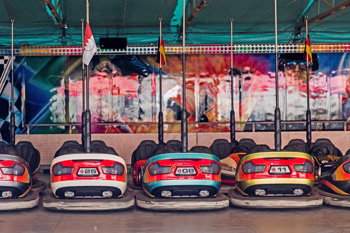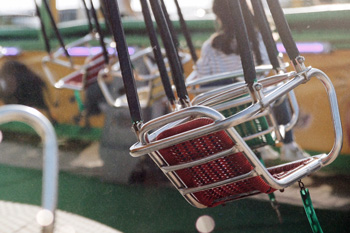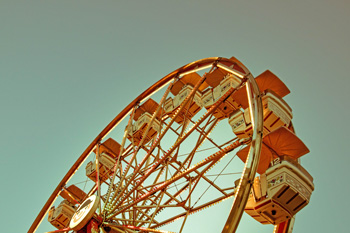Amusement Ride Safety
- Get Prepared
- General Safety
- Current: Amusement Ride Safety
Amusement Ride Safety Tips
A day at an amusement park or fair offers seemingly endless fun, but a tragedy can happen in an instant. The National Safety Council found that in 2023 about 1,500 people were injured while riding a fixed-site amusement ride in the United States and Canada. Some injuries may be unpreventable, but many can be avoided by following safety guidelines, observing ride activity and understanding how personal situations can affect the ride.
Amusement Ride Safety Tips
Ride Safety Tips
Quick Tips
- Read all posted rules and listen to instructions given by the ride's operator.
- Secure all clothing and personal possessions such as cell phones, hats, sunglasses and wallets.
- Always use all the safety equipment provided (seat belt, shoulder harness, lap bar, etc.).
- If children cannot be trusted to stay seated with hands and feet inside, do not let them ride.
- Explain to children that they should not get off a ride until the operator says to unload. Tell them not to exit the ride while it is still in motion.

Rules for Everyone
Below are some tips that everyone should follow regardless of age or special conditions.
- Read all posted rules and listen to instructions given by the ride's operator.
- Keep hands, arms, legs and feet inside the ride at all times.
- Secure all clothing and personal possessions such as cell phones, hats, sunglasses and wallets.
- A person of extreme height or weight size should pay close attention to all posted signs. If there is difficulty sitting in any seat properly, do not stay on that ride.
- Always use all the safety equipment provided (seat belt, shoulder harness, lap bar, etc.).
- Remain in the ride until it comes to a complete stop at the unloading point. If a ride stops temporarily due to mechanical failure or other reasons, stay seated and wait for an operator to provide further instructions.
- Do not board a ride if there are broken parts, signs of improper maintenance or an inattentive operator. Immediately call the IDHS Amusement Ride Hotline at 1-888-203-5020 to report this information.
- Every ride should have a prominently displayed, current permit issued by IDHS. The permit is about the size of a business card and is typically located at the operator's station. Permits are good for one year. If the ride has no such permit, or if the permit has expired, call the IDHS Amusement Ride Hotline at 1-888-203-5020 to report this information.
- Understand physical conditions and limitations. If personal health could be at risk for any reason, or if a pre-existing condition of any kind could be aggravated, do not board the ride.

Rides and Children
Do not put children on rides if they show extreme fear. The child could attempt to escape the ride, which could cause serious safety issues.
- Watch the ride while operating before boarding with children. Point out the operator and the entrance and exit locations prior to riding. Make sure they understand the instructions and warnings fully.
- Tell children to hold on tightly with both hands to lap bars, handholds or any other item designed specifically for hand placement. Explain this reduces the risk of injury.
- Obey minimum height, age and weight restrictions. Never sneak children onto rides they are too small or too young for because they may not be physically or developmentally able to stay safely seated.
- If children cannot be trusted to stay seated with hands and feet inside, do not let them ride.
- Load children to the inside, away from open doorways or on the side closest to the ride operator. Some rides will have very specific requirements.
- Explain to children that although rides sometimes stop temporarily, they should not get off until the operator says to unload. Tell them not to exit the ride while it is still in motion.

Patrons With Disabilities
Amusement facilities are making strides in inclusivity, but it is not always possible to include everybody. The forces exerted by some amusement rides or devices can be dangerous to a rider who cannot maintain the posture required for that ride.
- Upon entering an amusement facility, a guest with a disability should visit an information desk and request any information regarding access to the rides.
- Ask about specific amusement rides before someone with a disability is placed on the ride. Some rides can be too much for the person to handle mentally or physically. Operators can answer most questions about specific details of the ride.
- Many amusement rides and attractions have rapidly flashing lights that could cause a seizure.
- If someone is showing signs of distress before the ride begins, notify the operator and have the person get off the ride. A distressed person could attempt to escape during the ride, which would cause serious safety hazards.
Resources
Ride Issues and Inspections
The IDHS Elevators and Amusement Rides Section regulates all amusement rides in Indiana that are temporarily set up or permanently fixed, which includes traveling carnivals and fairs as well as locations such as Holiday World, Indiana Beach or the Indianapolis Zoo. IDHS even regulates mechanical bulls that may get set up at various locations.
Did You Know?
- IDHS inspectors check every ride annually prior to it taking riders the first time of the season.
- Every ride at the Indiana State Fair gets inspected again, even if it has already had its annual inspection that year.
- The ride inspection season usually lasts from March to November.
IDHS Amusement Ride Hotline
Call 1-888-203-5020 if an amusement ride appears to be improperly operated or maintained, or if it does not have a prominently displayed, current IDHS permit.
